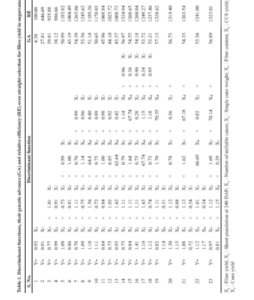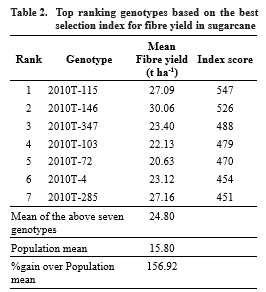SELECTION INDICES FOR FIBRE YIELD IN SUGARCANE (Saccharum spp.)
0 Views
M. SHANTHI PRIYA*, K.H.P. REDDY, M. HEMANTH KUMAR, V. RAJARAJESWARI, G. MOHAN NAIDU AND B. RUPESH KUMAR REDDY
Department of Genetics and Plant Breeding, S.V. Agricultural College, Tirupati-517 502.
ABSTRACT
Seventy-seven genotypes of sugarcane selected from the first clonal stage were evaluated at Agricultural Research Station, Perumallapalle, Andhra Pradesh, from 2011 to 2012 for diversified uses viz., biomass per cane, fibre yield, theoretical yield of alcohol, commercial cane sugar (CCS) yield and cane yield in second clonal stage. The main objective of a selection programme is to shift the mean to a new peak by directional selection. The plant breeder will have to base his selection on a combination of a few important characters related to the main character under consideration in the form of a selection index by appropriate weightages assigned to the phenotypic values of each character so that the genetic gain in the character under consideration will be maximum without any loss in other important characters. Selection indices provide the means for making use of correlated characters for higher efficiency in selection for characters of low heritability. Selection index is a tool, which breeder can use successfully for selection on several characters simultaneously by discriminating the desirable ones on the basis of phenotypic performance. Among one hundred and twenty seven different selection indices formulated for fibre yield, higher relative efficiency of 1328.62 coupled with high genetic advance (57.13) was exhibited by the combination involving six traits viz., fibre yield (X1), shoot population at 240 DAP (X2), number of millable canes (X3), single cane weight (X4), CCS yield (X6) and cane yield (X7)
KEYWORDS:
Selection indices, sugarcane, fibre yield.
INTRODUCTION
Sugarcane is an important cash crop and provides raw material for sugar industry, which is the second largest agro based industry of India. Sugarcane crop serves as the major source for a variety of products such as sugar, jaggery, molasses, bagasse, filter cake. It is realized that sugar production alone will not be able to make the industry profitable and under such circumstances diversification is a necessary consequence for the successful growth of industry. Sugar factories with cogeneration facility demand for high fibre varieties upto 16% as it helps in increasing the baggase availability (Natarajan, 2000). More than 500 sugar industries in the country have a potential to generate electricity of 5000 MW. However, the current installed capacity is only 2200 MW which is due to underutilization of full capacity of the industry to generate required quantity of bagasse and lack of energy canes with high fiber. Generally the main objective of sugarcane breeding is to develop varieties capable of producing high cane yield and CCS yield per unit land area. The recent awareness on the advantages of using green fuel for generation of power and use of gasohol to reduce automobile emission have resulted in setting up of a number of co generation plants in various sugar mills. As sugar production scenario is changing, varietal needs have started changing. Hence, breeding programmes must integrate new traits such as high fiber, high biomass and high total sugars in addition to yield and juice quality.
Efficiency of index selection over straight selection has been studied in various crops including sugarcane ever since the concept was proposed by Smith (1936) based on Fisher’s discriminant function. Straight selection is often based on arbitrary considerations, while index selection has the advantage that (i) it is based on genotypic considerations, (ii) the different characters can be suitably weighed according to their relative importance and (iii) simultaneous improvement might be possible for the target character as well as the associated attributes. Discriminant function is useful in knowing the extent of improvement that can be achieved in a dependent character by selecting plants based on different combination of independent component characters. When a trait is associated with other characters, indirect selection through such traits is sometimes likely to be better than straight selection. But, when the number of characters associated with a trait is large, it becomes difficult to select simultaneously for all the characters. Under such circumstances, selection indices formulated involving different combinations of characters giving appropriate weightage to each character helps in making the selection procedure easy.
The technique of discriminant function developed by Fisher (1936) was adopted to know the genotypic worth of clones with respect fibre yield and their components so as to have computational formulae for construction of selection indices which when applied for selection can bring about effective improvement in these traits compared to straight selection.
MATERIAL AND METHODS
The present investigation was carried out at Agricultural Research Station, Perumallapalle (Acharya N.G. Ranga Agricultural University), situated in the Southern Agro-climatic Zone of Andhra Pradesh, India. Seventy-seven genotypes along were planted in a randomized block design with two replications during April, 2011. Each entry was planted in 2 rows of 5 m length spaced at a distance of 80 cm between rows with 4 three budded setts per meter as seed rate. Fertilizers were applied at recommended dose of 224:112:112 kg ha-1 N, P2O5 and K2O, respectively for plant crop and 336:112:112 kg ha-1 N, P2O5 and K2O, respectively for ratoon crop. The recommended dose of P2O5 and K2O were applied as basal and nitrogen was applied in two equal split doses at 45 and 90 days after planting for plant crop. In ratoon crop, full dose of P2O5, K2O and half dose of nitrogen were applied at the time of ratooning and remaining dose of nitrogen was applied at 45 days after ratooning. Cultural practices like weeding, irrigation, earthing up and propping were followed to maintain good crop growth.
Data was recorded for all the seventy-seven genotypes for the characters viz., tiller number at 90 DAP, shoot population at 180 and 240 DAP, NMC per plot, number of green leaves at 90, 120, 240 DAP and at maturity, biomass per cane, internode number, internode length, stalk length, stalk diameter and stalk volume, cane yield, fibre content, fibre yield, sucrose in juice, commercial cane sugar (CCS), juice purity, pol percent cane, juice extraction %, Brix, CCS yield, and theoretical yield of alcohol.
RESULTS AND DISCUSSION
Fibre yield showed significant positive association with shoot population at 240 DAP (0.510), number of millable canes per plot (0.507), single cane weight (0.459), fibre content (0.389), CCS yield (0.686) and cane yield (0.779).Among seven characters that were used to formulate selection indices, fibre yield (X1) was considered as dependent character while other characters viz., shoot population at 240 DAP (X2), number of millable canes (X3), single cane weight (X4), fibre content (X5), CCS yield (X6) and cane yield (X7) which showed significant positive association with fibre yield were considered as independent variables. The top twenty three out of one hundred and twenty seven discriminant functions and the estimated values of genetic advance and relative efficiency for each combination of characters over straight selection for fibre yield were presented in Table 1 and briefly discussed below. The top ranking genotypes based on the best selection index for fibre yield were presented in Table 2.
Out of one hundred-and-twenty-seven different selection indices formulated, higher relative efficiency of 1328.62 coupled with high genetic advance (57.13) was exhibited by the combination involving six traits viz., fibre yield (X1), shoot population at 240 DAP (X2), number of millable canes (X3), single cane weight (X4), CCS yield (X6) and cane yield (X7) followed by the combination of five traits viz., fibre yield (X1), shoot population at 240 DAP (X2), number of millable canes (X3), CCS yield (X6) and cane yield (X7) which recorded relative efficiency of 1324.94 with genetic advance of 56.97.
Among single characters, cane yield (X7) was highly efficient with relative efficiency of 646.69 and high genetic advance of 27.81, compared to the direct selection based on fibre yield (X1). Whereas among two character combinations, maximum relative efficiency of 925.88 was observed for the combination of number of millable canes (X3) and cane yield (X7) with high genetic advance of 39.81. However, in case of three character combinations, the combination involving shoot population at 240 DAP (X2), number of millable canes (X3) and cane yield (X7) exhibited high relative efficiency of 1185.82 coupled with high genetic advance of 50.99.
Among four character combinations, fibre yield (X1), shoot population at 240 DAP (X2), number of millable canes (X3) and cane yield (X7) exhibited high relative efficiency of 1265.06 coupled with high genetic advance of 54.39.


In the present investigation, the selection indices constructed with the inclusion of more than one character gave higher genetic advance and relative efficiency over straight selection for fibre yield. Similar results were reported in the selection indices formulated for cane yield, CCS yield and yield components in Dosado et al. (1980), Singh and Khan (1998), Singh et al. (2003), Krishna and Singh (2005) and Priya et al. (2013).
The selection indices constructed with the inclusion of more than one character gave higher genetic advance and relative efficiency over straight selection for fibre yield. When indirect selection scheme excluding fibre yield is to be followed, the index involving the combination of six characters viz., shoot population at 240 DAP (X2), number of millable canes (X3), single cane weight (X4), fibre content (X5), CCS yield (X6) and cane yield (X7) which exhibited maximum relative efficiency of 1241.00 with genetic advance of 53.36 could be considered for selection schemes to improve fibre yield.
LITERATURE CITED
Dosado, V.G., Tapay, R.E and Miayo, H.M. 1980. Selection indices for high yield in sugarcane. Proceedings of International Society of Sugarcane Technologists. 17: 1104-1110.
Fisher, R.A. 1936. The use of multiple measurements in taxonomic problem. Annals of Eugenics. 7: 179-188.
Krishna, K and Singh, P.K. 2005. Selection indices in mid late maturing clones of sugarcane (Saccharum complex hybrid). Crop Improvement. 32(2): 173-177.
Natarajan, U.S. 2000. Breeding for quality improvement in sugarcane. Proceedings of winter school on Sugarcane Breeding and Genetics in Retrospect and Prospects. 3rd to 24th October, Coimbatore. pp. 16-21.
Priya, M.S., Reddy, K.H.P., Kumar, M.H., Rajarajeswari, V., Naidu, G.M., Narasimhulu, R., Reddy, B.R.K and Reddy, D.M. 2013. Selection indices for cane yield in sugarcane (Saccharum spp.). Indian Journal of Plant Sciences. 2(3): 2319-3824.
Singh, S.P and Khan, A.Q. 1998. Selection indices for cane yield in sugarcane. Indian Journal of Genetics and Plant Breeding. 58(3): 353-357.
Singh, A., Bhatnagar, P.K., Khan, A.Q and Shrotria, P.K. 2003. Association of quality characters with cane and commercial cane sugar yields in sugarcane. Sugar Technology. 5(3): 197-198.
Smith, H.F. 1936. A discriminant function for plant selection. Annals of Eugenics. 7: 240-250.
- Genetic Divergence Studies for Yield and Its Component Traits in Groundnut (Arachis Hypogaea L.)
- Correlation and Path Coefficient Analysis Among Early Clones Of Sugarcane (Saccharum Spp.)
- Character Association and Path Coefficient Analysis in Tomato (Solanum Lycopersicum L.)
- Survey on the Incidence of Sesame Leafhopper and Phyllody in Major Growing Districts of Southern Zone of Andhra Pradesh, India
- Effect of Organic Manures, Chemical and Biofertilizers on Potassium Use Efficiency in Groundnut
- A Study on Growth Pattern of Red Chilli in India and Andhra Pradesh

